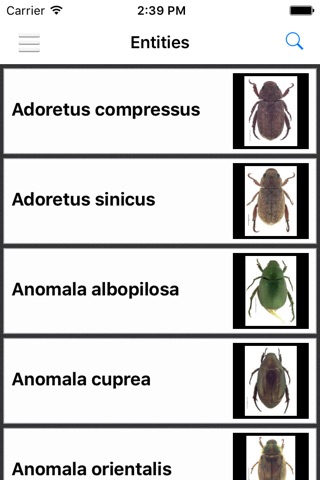
Hawaiian Scarab ID
Développeur United States Department of Agriculture-APHIS
The megadiverse Scarabaeoidea (scarabs, stags, and bess beetles) consists of over 31,000 species that are distributed worldwide and includes many important agricultural pests, agents of biological control of dung and dung flies, important pollinators, and species used as habitat bioindicators (Jameson and Ratcliffe, 2002; Ratcliffe, et al., 2002). Despite their ecological, evolutionary, and economic significance, there is an overwhelming lack of expertise on these insects. The lack of knowledge is of concern because many species are invasive agricultural and economic pests. Conservation of native scarabs and the conservation impact of non-native scarabs is an additional concern. Once established, scarab pests are extremely difficult to dislodge, and a full range of technologies and controls is needed for their eradication (Jackson and Klein, 2006).
This key allows you to easily identify adult and immature scarab beetles including established pest species and potential new invasive scarab species. The key includes scarab beetles that are of biosecurity risk, such as the Chinese rose beetle (Adoretus sinicus) and the coconut rhinoceros beetle (Oryctes rhinoceros), as well as scarab beetles that are beneficial recyclers of cattle dung, such as the gazelle dung beetle (Digitonthophagus gazella) and tumble bugs. The scarab and stag beetle fauna of Hawaii is of global origin, with non-native species hailing from Australia, Africa, North America, Asia, and Europe. Only five stag beetles are native to Hawaii, and these are greatly in need of conservation and study. Guam is a key introduction pathway for many species that have been introduced to Hawaii. This tool may also be useful in other geographic regions that may be impacted by invasive scarab beetles, including Florida, California, Puerto Rico, Virgin Islands, and the American Pacific. It is designed for people with varying degrees of knowledge, from outdoor enthusiasts to research scientists.
All images were produced by Emmy L. Engasser, except where noted in image captions. The splash screen and app icons were developed by Jackie Baum. Please see the Hawaiian Scarab ID website for proper guidelines for use and citation of images.
Key author: Joshua Dunlap
Fact sheet authors: Joshua Dunlap and Mary Liz Jameson
Original source: This key is part of the complete Hawaiian Scarab ID tool at http://idtools.org/beetles/scarab/ (requires internet connection). Full references for all citations may be found at this website, along with checklists for scarabs present in Hawaii and Guam, and much more.



